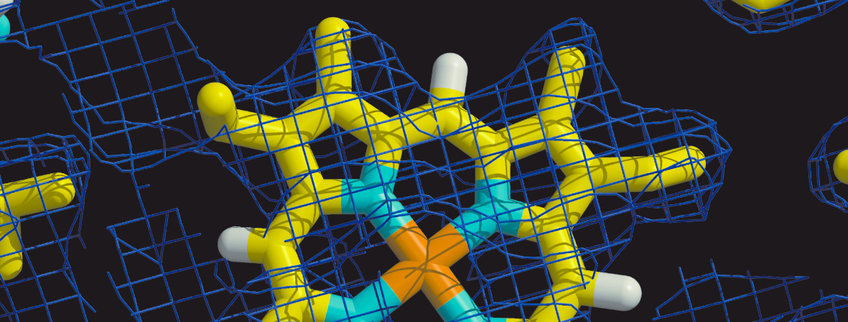
G-Protein Coupled Receptors
Project Group of Department of Molecular Membrane Biology (MMB)
In mammals G-Protein coupled receptors (GPCRs) form the most abundant superfamily of integral membrane proteins. They are important mediators for signal transfer interacting with signalling molecules at the outer surface of the cell membrane and transducing the signal across the membrane. Examples for such signalling molecules are non-steroid hormones, neurotransmitters, odorants and (in the case of rhodopsin) even light. GPCRs can be found in all kinds of eukaryotes from amoeba to fungi, plants, invertebrates and vertebrates. The genome of the human body codes for close to 900 GPCRs, around 400 of them are olfactory receptors. For many GPCRs the natural ligand has not been identified, these receptors are called orphan GPCRs.
It has been estimated that ~50 % of all medicinal drugs act via binding to GPCRs. Therefore it is not only of great interest for basic science to understand signal transduction by GPCRs, but also for the pharmaceutical industry because structural knowledge on GPCRs can be applied for drug design and virtual screening.
A typical GPCR consists of 7 membrane spanning helices. These are connected by hydrophilic loops termed - according to their occurrence - extracellular loop (EL1 - EL3) or intracellular loop (IL1 - IL3). Besides that they carry an extracellular N-terminal tail and an intracellular C-terminal tail, which is palmitoylated in many cases.
Signal transduction is initiated by binding of a specific ligand to the receptor. Depending on the type of ligand, they bind to intramembrane binding sites (amines, nucleotides or lipids) or extracellular binding sites (proteinases, neuropeptides or proteohormones). There are two types of ligands for GPCRs: Ligands that activate the receptor for signalling ("agonists"), and ligands that render the receptor temporarily inactive ("antagonists"). Interaction with an agonist leads to a conformational change in the GPCR, while interaction with an antagonist blocks binding of other ligands and fixes the GPCR in an inactive conformation, thus preventing any transmembrane signalling. There are also allosteric inhibitors.
Binding of an agonist induces a conformational change in the receptor that is then transduced to its cytoplasmic side, where the GPCR interacts with heterotrimeric G proteins. These proteins (comprised of the subunits alpha, beta and gamma, with a GDP/GTP binding site on its alpha subunit) only form a stable heterotrimer in their GDP form. It is yet unclear whether heterotrimeric G proteins are constitutively attached to the GPCR, or whether agonist-activated receptors interact with the G proteins on a random-collision basis. The activated receptor now acts as a GDP/GTP-exchange factor for the G protein bound to the GPCR on the cytoplasmic side of the membrane, inducing dissociation of the heterotrimeric G protein and release of active GTP-Gα. These Gα proteins now transduce the ligand-induced signal by activating enzymes catalyzing the production of second messengers (for example activating adenylylcyclase or phospholipase C). After a short time, both the intrinsic GTPase activity of Gα and other GTPase Activating Proteins (GAPs) lead to hydrolysis of the Gα-bound GTP, rendering the Gα inactive and allowing re-formation of the heterotrimeric G protein (Gα/β/γ).
However, as is the case for most membrane proteins, all GPCRs (apart from rhodopsin, which is a light activated GPCR) are found in cells in very small amounts only. Since milligram amounts of stable and homogenous protein are a prerequisite for biophysical and structural studies, we focus on one hand on the heterologous production of recombinant GPCRs in various expression systems, and on the other hand on the establishing of purification protocols, biochemical and biophysical examinations and protein crystallisation for X-ray structure determination. In the past we have used the baculovirus system and insect cells, Escherichia coli, various yeasts (Saccharomyces cerevisiae, Schizosaccharomyces pombe, Pichia pastoris) and the Semliki Forest virus mediated expression in mammalian cell lines. In a genomics type of approach we have worked on more than 100 different GPCRs with the aim of identifying the most suited GPCRs. At the moment we have narrowed down the number of GPCRs to less than a dozen. These are expressed in Pichia pastoris, in insect or in mammalian cells depending on the receptor. We also test cell-free coupled transcription translation systems for the production of GPCRs.
Our goal is to determine the structure of native GPCRs and functional GPCR-protein complexes in their active state. Most of our targets originate from mammalian species, like human, mice and rat. We also collaborate with NMR groups (Prof. C. Glaubitz, Uni Frankfurt, Prof. H. Oschkinat, FMP, Berlin) in order to determine the conformation of peptide ligands in the receptor bound state by solid state nuclear magnetic resonance spectroscopy.
Our structural studies are complemented by collaborative fluorescence spectroscopic techniques in order to get information about the oligomeric state of our GPCRs in their native membranes.